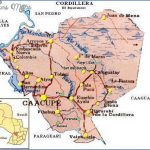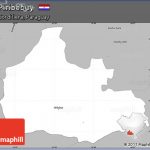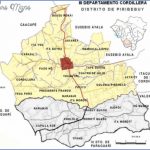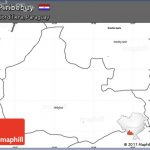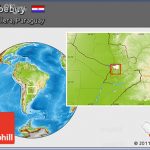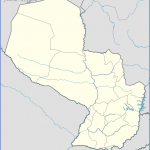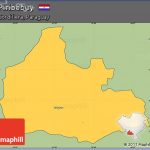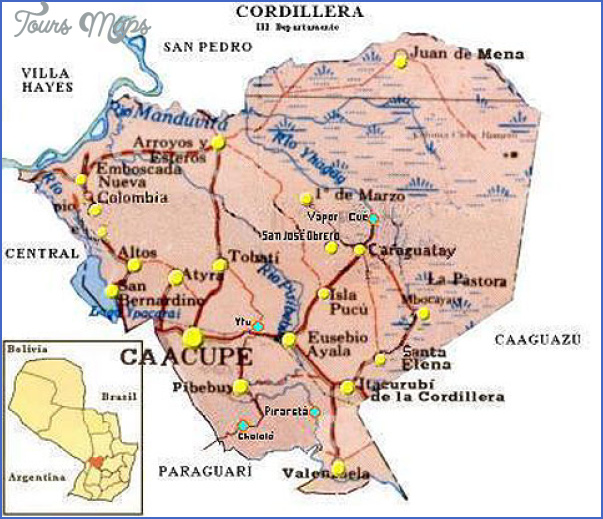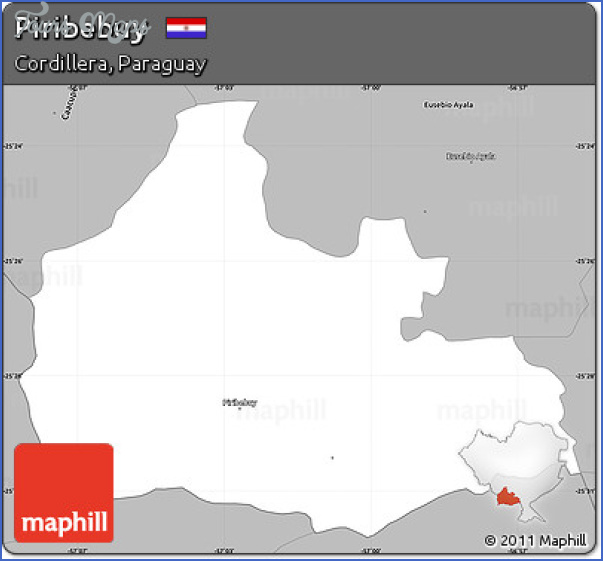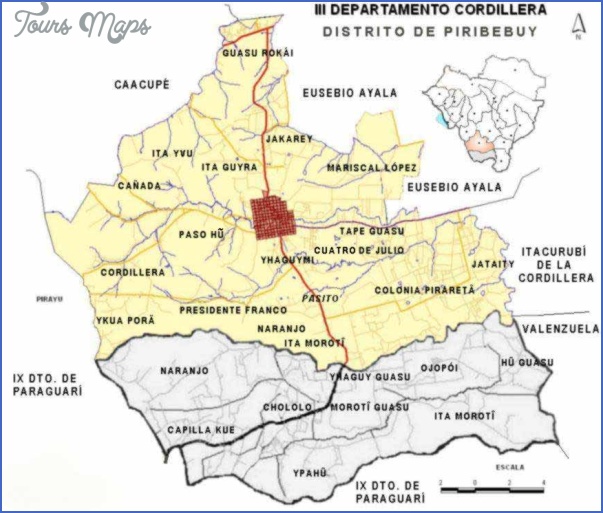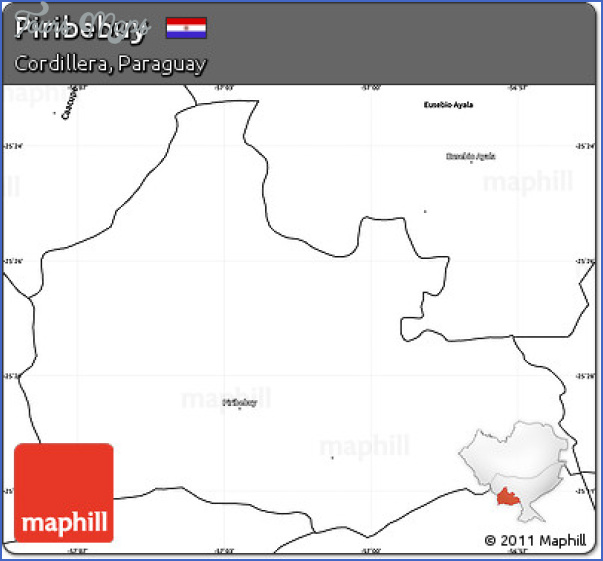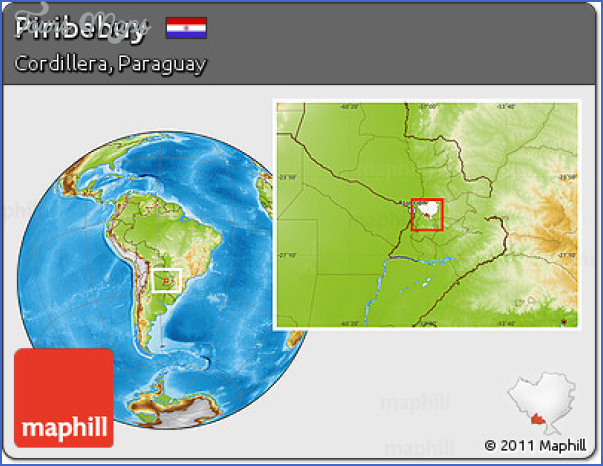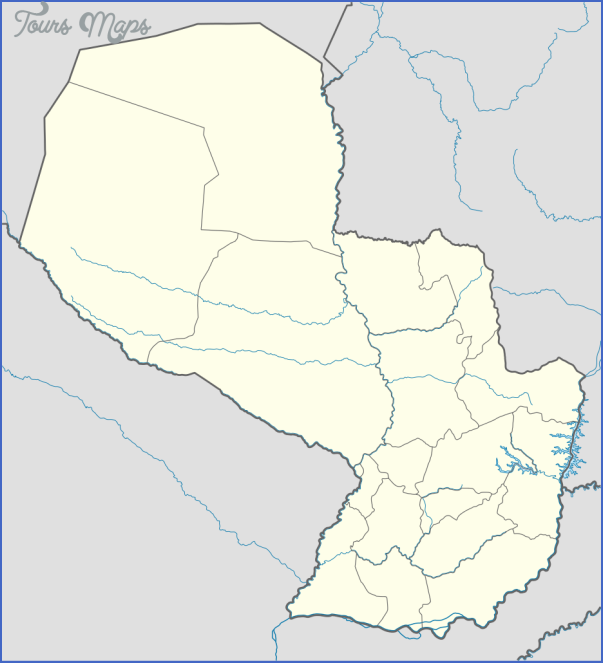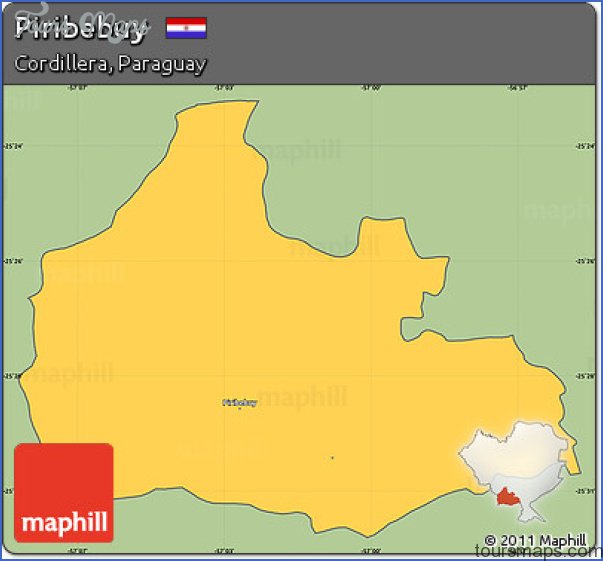Piribebuy is one of the larger towns tucked away from Route 2 in the Cordillera department. The area’s rolling hills and relative proximity to Asuncion make it a draw for vacationers, many of whom have summer homes here. An increasingly small number of artisans in town still create the labor intensive poncho sesenta lista, said to have been a favorite of Mariscal Lopez. The town is home to two religious festivals which take place during the summer, the Fiesta de San Blas which brings in pilgrims from afar and the celebration of Nandeyara Guazu. For those interested in experiencing Paraguay’s religious traditions these are lower key alternatives to the neighboring celebration of the Dia de la Virgen de Caacupe.
Piribebuy is a nice example of a small yet economically prosperous Paraguayan town. There are several large factories in the area including those of Piri Cola sodas and Cana Fortm alcohol as well as a nearby munitions factory. These businesses draw workers from the region and bring money into the town. There are many small businesses in the center of town though fortunately the main plaza and surrounding areas are still quite tranquilo. The further you venture down cobblestone roads the more rural life becomes and, due to the area’s many hills, the verdant scenery is lovely. As with much of the Cordillera department many Asuncenos have vacation homes here and there are many European retirees living here as well (there is even a German gated community, Topachi Ranch). Those who wish to delve into small town life should stay in town while visitors who’d prefer to enjoy the natural scenery will prefer larger, more touristy ranches along the road to Paraguari.
In terms of history, the town has the dubious distinction of having been one of the only urban areas to see action during the Triple Alliance War. Unfortunately the situation was quite tragic for the town’s residents. Four years into the brutal Triple Alliance War the Paraguayan government headquarters was moved to Piribebuy, having previously relocated from Asuncion to nearby Luque. In August of 1869 the Battle of Piribebuy was waged between 20,000 Triple Alliance troops and 1,600 Paraguayans, most of whom were women, children and the elderly. Amongst this band of poorly armed patriots was a group of 200 school children from Villarrica, marched to the battle front by their teacher Maestro Fermin Lopez. The battle was short lived and the majority of the survivors executed. To top off the atrocities the hospital was set afire with 600 patients still inside. Only days later a similarly unequipped army made up of mostly children was massacred in nearby Acosta Nu (see Los Ninos Martires de Acosta Nu). Months later Marsical Lopez would be fatally wounded to the north in Cerro Cora but by this point the war was already lost. This brutal episode is the reason Piribebuy is also known as the ciudad heroica (heroic city).
Sidebar: Piribebuy means slight chills or goosebumps in Guarani and is a reference to the area’s cool temperatures.
Fiesta de San Blas
At the entrance to Piribebuy there is a small oratory erected to hold a statue of San Blas. Every year he is honored on February 2nd with pilgrimages frompromeseros who have promised their devotion in honor of San Blas’ protection. Many of the younger promeseros don burgundy capes laced with yellow trimmings and crowns in honor of the saint. Though it is a dying tradition there are still several families that journey to Piribebuy in ox drawn carts for the festivities. The intersection of Maestro Fermin Lopez and Pedro Juan Caballero is a traditional campgrounds for these pilgrims. Carts and camping equipment are set up along the sidewalk and ox are allowed to graze up the street in the grounds of the Colorado party headquarters (the seccional Colorada) on the corner of Mariscal Estigarribia and Pedro Juan Caballero. During the festival many of Piribebuy’s inhabitants prepare a large meal known as a kaaru guazu to share with pilgrims. Others may distribute prepared food for free. The festivities include a procession from the oratory to the church on the morning of the 2nd, and a celebratory mass in Piribebuy’s main plaza on the morning of the 3rd followed by a procession back to the oratory. The night of the 2nd the town’s two social clubs, the Club 12 de Agosto and Club Independiente (both on General Diaz) throw rivaling parties that bring in revelers from all over as well as a fare share of pilgrims. These large dance parties feature big name national musical acts as well as the occasional international band.
Sidebar: According to lore, San Blas cured a small child with a fish bone stuck in her throat. Because of this he is believed to protect those with throat ailments. In Paraguay it is common for people to exclaim Sr. San Blas! if someone has a fit of coughing.
Mito Totem Pole
Just before the turn off to Piribebuy, on Route 2, there is a large totem pole depicting the mythical characters said to roam the surrounding countryside (see Meet the Mitos). At the base is the cave dwelling Monai serpent. His arm extended, the pale Jasy Jatere beckons child victims while the Kurupf stares out vacantly, his enormous phallus wrapped several times around his torso. Up top is Tupa, God. While the mito totem pole may be in desperate need of repair its deteriorating state does serve one purpose – it makes the Mitos seem even creepier than usual. Km 63, Route 2 on the left-hand side of the road approximately one kilometer before the turn off to Piribebuy.
Balneario & Arroyo Piribebuy
Piribebuy’s main creek or arroyo is located about two blocks downhill from the town plaza.
Though there are some sandy strips but for the most part the shores to either side are grassy and make for a nice picnic spot. When the water level is high enough the small water lock is closed creating the sandy-bottomed municipal pool. During the summer there are often bathers enjoying the cool water and shade from the surrounding eucalyptus trees.
Museo Municipal Capitan Pedro Pablo Caballero
The town museum contains a collection of artifacts pertaining to both the Chaco and Triple Alliance War. The museum’s curator, Miguel Angel Romero is very knowledgeable about the town’s history and can explain in detail Piribebuy’s role during the Triple Alliance War. He is also a sculptor of saints (see Santeros) and usually has several pieces in progress in the back room of the museum On occasion he will take tourists on a tour of the town church though this depends on the mood of the town priest. Displayed without much fanfare is a traditional poncho para ‘i sesenta listas a local handicraft that is very difficult to make (see the following Poncho Para’i de Sesenta Listas). Tel: 0515 212 202,0971 179 437 Corner of Mariscal Estigarribia and Yegros with a replica of a cannon out front, Mon-Sat 7am-12pm Monumento Batalla de Piribebuy
The battle of Piribebuy is commemorated with a large relief mural located at the site of the Triple Alliance era hospital known as the Hospital de Sangre. The mural depicts the women and children of Piribebuy defending their town against Triple Alliance forces. In the lower left-hand corner a fire rages in the Hospital de Sangre. In the center is Maestro Fermm Lopez, who led his child pupils into battle. The walk to the mural, past a plaza where children often play soccer, is very picturesque and it can be hard to imagine such atrocities taking place against this peaceful backdrop. From the Viejo Rincon or the town plaza follow Maestro Fermin Lopez as it crosses Route 2. You will pass over a small creek immediately after crossing the highway and there will be a large plaza on your left-hand side. At the corner take a right – the monument, two blocks away, will already be visible.
Poncho Para’i de Sesenta Listas
The poncho para’i de sesenta listas is a style of poncho that has been made in Piribebuy since the era of Dr. Francia. These beautiful ponchos are hand-woven from fine cotton sewing thread. Working full time four people can complete one poncho in two weeks. Each poncho sesenta listas has three components: the main body of the poncho, a strip along the entire edge of the poncho called afaja or randa and the fringe which hangs along the edge of the poncho. As the name indicates the poncho contains sixty white listas, or stripes, the width of which can vary and is up to the personal preference of the weaver. Traditionally the ponchos are black and white although modern tastes have lead to the incorporation of other colors. Due to the length and intricate patterns it incorporates the faja is the most complicated section, taking up to ten days to make. Unfortunately, there is no permanent exhibition space in town yet. The best place to see ponchos being made is in the workshop of Rosa Segovia (see the following section). Local artisans also tend to set up stands in the town plaza in the days before the Festival de Poncho Sesenta Listas, a music festival held on the third Friday of every January.
Rosa Segovia’s Poncho Para’i de Sesenta Listas Workshop
Piribebuy’s most renowned poncho sesenta listas artisan is Rosa Segovia, an animated women who is happy to receive visitors in her workshop. Each poncho costs around Gs.1,200,000, of which about 75 percent goes towards material costs. According to Rosa Segovia the weavers continue to make poncho sesenta listas for the love of the art rather than for a tidy profit. Rosa Segovia has
also started making more modern items out of her sesenta listas cloth such as handbags and wallets. These are a nice, more affordable alternative to the traditional poncho. Tel: 0515 212 097, 0972 649 753, to get to Rosa Segovia’s house from the town plaza head towards the main road along either Maestro Fermin Lopez or Mariscal Estigarribia. Take a right towards Paraguari. You will pass a Copetrol station on your right and cross over a small bridge. A block further there is a large highway sign indicating distances to Itacurubi de la Cordillera. At the sign take a left and continue three blocks past a field, hospital (centro de salud) and a soccer court all on the left. Take a left and continue halfway down the block to a brick house marked number 3051 with a small ice cream stand (Helados San Cayetano ) in front.
Plata Yvygy & Other Ghostly Reminders of the War
The phenomenon of plata yvygy is well known throughout Paraguay, but is especially prevalent in ex-battle grounds from the Triple Alliance war. The phrase means money under the earth and rumors of buried treasure from the war abound. Specifically, people are on the hunt for several wagons packed with gold coins which were moved to Piribebuy when it was temporarily declared the national capital during the last stages of the war. According to legend the presence of plata yvygy is indicated by several supernatural phenomena including strange glittering lights on the horizon and unexplained noises at night. However these treasures can prove elusive – according to legend only certain people possess the ability to unearth them. Many Paraguayans trust their odds though; the classifieds always feature several ads for metal detectors.
Lodging
Hotel Piribebuy The newest hotel in town Hotel Piribebuy lacks the character of El Viejo Rincon but is more comfortable. Tel: 0515 212 994, 0981 265 153, corner of General Diaz and the Ruta General Rogelio Benitez, Single Gs. 100000, double: Gs. 120,000, TV, A/C
El Viejo Rincon This old house turned hotel and restaurant is very similar to the majority of houses in town – high ceilings, tiled roofs, a wrap around patio and worn brick floors. Rooms are quite small and basic. The restaurant has excellent chipa guazu and milanesa and the bife al caballo is perfectly cooked every time. Tel: 0515 212 251, corner of Maestro Fermin Lopez and Horacio Gini two blocks from the town plaza, doubles Gs. 70,000 with fan, 120,000 with A/C, food Gs. 10,000-30,000, daily 7am-3:30pm, 5pm-9pm
San Francisco Country Club Located right on the road to Piribebuy this complex has cute thatched roof bungalows, a castle shaped restaurant and pools and walking paths for relaxing and enjoying the outdoors. Bungalows are rustic looking on the outside but comfortable on the inside. The Piribebuy bus passes right in front, should you want to head into town. Tel: 0516 250 301, 0981 802 253, km 66 Ruta General Rogelio Benitez, www.sanfrancisco-country.com, two person bungalows: Gs. 220,000-270,000 per person with a fee of Gs. 30,000 -40,000 for an additional person. A/C, fan, pool
Food
El Viejo Rincon The best option in town. See previous listing for information
Rikuras A place to satisfy your sweet tooth with homemade desserts and ice creams. Conveniently enough it is just down the street from El Viejo Rincon. Tel. 0515 212 262, Maestro Fermin Lopez almost Horacio Gini, Daily 8am-6pm, Gs. 8,000-20,000
El Eden Set up in a private home this dance club offers basic Paraguayan fast food options served at tables in the front yard. There are several hamburger and empanada joints further up
the road towards the social clubs. Tel: 0515 212 252, 0984 145 281, General Diaz almost at Heroinas de Piribebuy www.eledenrestaurante.es.tl, Gs. 10,000-25,000, Saturdays 7pm-12:30am
Getting There
Driving from Asuncion take the signed right-hand turn off at km 64 of Route 2. If you pass the Chiperia Maria Ana on your right then you have gone too far. The center of town is to the right-hand side about nine kilometers from the turn off. If traveling from Asuncion along Route 1 there is a large sign for the Eco Reserva Mbatovf along the left-hand side of the road just past the center of town. Follow this road and take a left, just after the town church and the next right down a double avenue. The paved road will eventually swing to the left and head away from the center of town towards Piribebuy.
Empresa Piribebuy buses leave Asuncion’s bus terminal hourly (sometimes as frequently as every half hour) from 5am or so till about 8pm. From the Piribebuy’s bus terminal it is about a four block walk to the town plaza. Bus fare is Gs. 7,000.
Continuing past Piribebuy towards Paraguari
Piribebuy Map Paraguay Photo Gallery
Maybe You Like Them Too
- The Best Cities To Visit in The World
- World’s 10 Best Places To Visit
- Coolest Countries in the World to Visit
- Travel to Santorini, Greece
- Map of Barbados – Holiday in Barbados

